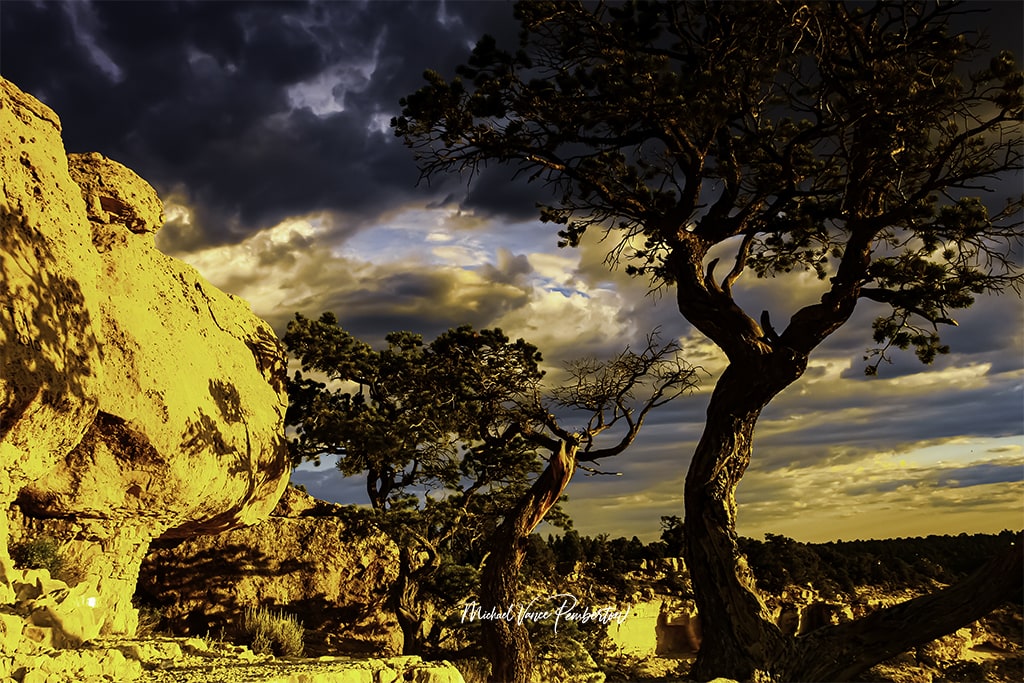
The Grand Canyon is an iconic testament to the grandeur and beauty of nature’s artistry. Its breathtaking vistas, dramatic play of light and shadows, and the sheer scale of its rugged landscapes make it a photographer’s paradise. Whether you’re a seasoned pro or an amateur enthusiast, photographing the Grand Canyon is an experience that demands skill, patience and a deep appreciation for the wonders of the natural world. In this article, I will share my best tips for capturing the essence of the Grand Canyon through your lens.
1. Timing is Everything:
The Dance of Light and Shadow: Mastering Grand Canyon Photography.
Landscape photography is an art form that relies heavily on the interplay of light and shadow, and nowhere is this relationship more striking than at the Grand Canyon. This natural wonder is a canvas upon which the sun paints an ever-changing masterpiece, creating a visual symphony that photographers yearn to capture. Understanding the dynamics of light and the transformation of the canyon’s features throughout the day is the cornerstone of successful Grand Canyon photography.
The Grand Canyon awakens in a spectacle of colors and contrasts as the sun graces the horizon. The golden hours, those precious moments shortly after sunrise and just before sunset, bathe the landscape in a warm and delicate light. This gentle illumination caresses the canyon’s intricate textures and highlights the subtle hues that define its character. The soft glow of these hours softens the harsh edges, making the rock formations appear almost ethereal as if painted by an artist’s brush.
During the golden hours, the shadows cast by the canyon’s cliffs and ridges are long and dramatic. These shadows carve intricate patterns that accentuate the depth and contours of the landscape. Each crevice, ridge, and terrace becomes a canvas for the interplay of light and darkness, revealing a sense of three-dimensionality essential for conveying the Grand Canyon’s immense scale in a two-dimensional photograph.
In contrast, the midday sun, at its zenith, can be unforgiving to even the most skilled photographer. The light is harsh, creating solid contrasts and washing out colors. Details become obscured, and the canyon’s grandeur is diminished under the weight of stark shadows and overexposed highlights. This is when the canyon takes on a more monochromatic appearance, with its subtleties muted by the intensity of the overhead light.
To truly capture the Grand Canyon’s depth, drama, and vibrancy, photographers should aim for the magic moments of dawn and dusk. With its gentle transition from darkness to light, the sunrise unveils the canyon gradually, offering opportunities to compose shots that tell a story of awakening. Conversely, the sunset bathes the landscape in warm, golden hues that evoke a sense of tranquility and closure. During these times, the canyon’s true character is most faithfully revealed through the lens.
As you embark on your journey to photograph the Grand Canyon, remember that its beauty is not simply a static landscape but a dynamic masterpiece crafted by the hands of light and shadow. By embracing the golden hours and respecting the nuances of lighting, you can craft photographs that capture the canyon’s visual splendor and convey the emotions and experiences that unfold within its vast embrace. In this grand theater of nature, every sunrise and sunset is a new act in the eternal play of light – an opportunity for you to tell your own story through the art of photography.

2. Choose the Right Gear:
Equipping Your Vision: Tools for Crafting Grand Canyon Memories.
In the realm of photography, the power of equipment cannot be understated, and when it comes to capturing the awe-inspiring grandeur of the Grand Canyon, choosing the right gear can be a pivotal factor in the quality of your images. The possibilities are as diverse as the canyon’s landscapes, from high-end cameras to the humble smartphone.
The choice between a dedicated camera and a smartphone is at the forefront of this decision. While high-end cameras can produce stunning, high-resolution images that capture even the finest details of the canyon, it’s essential to acknowledge that photography isn’t confined solely to those with advanced equipment. In fact, the advancements in smartphone camera technology have bridged the gap significantly. Even a smartphone can capture the essence of the Grand Canyon, translating its breathtaking vistas into memories you can hold.
However, if you’re eager to invest in equipment tailored to the task, specific tools can elevate your Grand Canyon photography to new heights. A wide-angle lens stands as a cornerstone of canyon photography, offering the ability to encompass the vastness of the landscape within a single frame. The canyon’s intricate layers and sweeping panoramas can be effectively captured through a well-chosen wide-angle lens, allowing you to tell the story of its depth and scale.
In the realm of accessories, a sturdy tripod is an unsung hero. This unassuming tool is crucial in maintaining image sharpness, particularly in low light conditions common during dawn and dusk shoots. The Grand Canyon’s shifting lighting conditions demand longer exposures to capture the intricacies of its contours and textures.
A tripod ensures that your images remain crisp, preserving the finer details that contribute to the authenticity of your photographs.
The presence of water within the Grand Canyon offers yet another opportunity to explore your equipment’s potential. A sturdy tripod is indispensable if you photograph the Colorado River and its cascading waterfalls. By allowing for longer exposure times, the tripod transforms rushing water into a silky cascade, adding an element of motion and serenity to your composition.
Your choice of equipment – be it a smartphone or a sophisticated camera with an array of lenses – reflects your vision and intent as a photographer. The Grand Canyon is a symphony of colors, textures, and emotions waiting to be captured. With the right tools, you can become the conductor of this visual masterpiece, orchestrating each element into a harmonious composition that resonates with the spirit of this geological wonder. Whether you opt for the convenience of a smartphone or the versatility of specialized equipment, remember that your creative eye and passion will ultimately shape how you immortalize the Grand Canyon’s majesty.
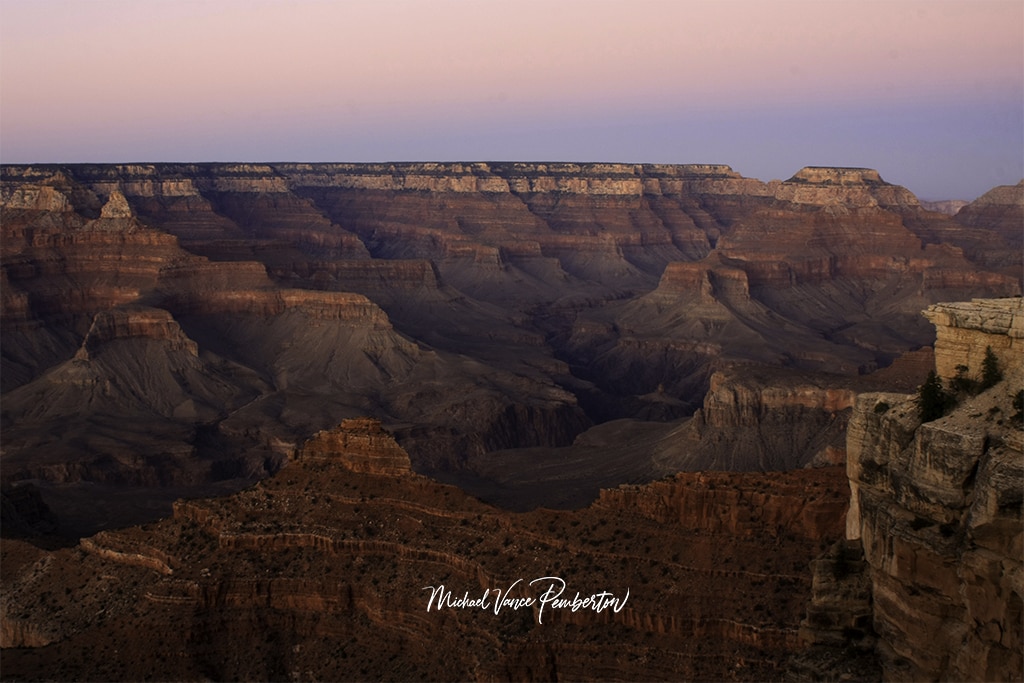
3. Framing and Composition:
Crafting Visual Narratives: Composing Grand Canyon Photography.
The Grand Canyon is not merely a subject for your lens; it’s a canvas of geological wonders, a palette of colors, and a playground of light and shadow. Your role as a photographer is to translate its grandeur into a visual narrative that captures its essence. This journey of creative expression begins with strategically using the canyon’s unique topography to your advantage.
As you stand on the precipice of this natural marvel, take a moment to consider how the canyon’s contours can guide your composition. The towering walls and winding river below create a symphony of lines that can be woven into your images. Experimentation is key – play with these lines as leading elements, drawing the viewer’s gaze into the heart of the canyon. Allow these lines to guide the eye, fostering a sense of depth that mirrors the grandeur of the landscape itself.
Moreover, embrace the natural framing opportunities that the canyon provides. With their rugged edges and deep shadows, overhanging rocks can serve as majestic frames for your compositions. These natural arches create windows to the breathtaking landscapes beyond, adding an element of intrigue to your photographs. They offer a sense of scale and a touch of mystery, inviting viewers to explore the hidden realms of the canyon.
Foreground elements hold immense power in landscape photography, and the Grand Canyon is no exception. By incorporating features such as a resilient cactus, a weathered boulder, or a delicate wildflower, you add a sense of scale and infuse your images with context and depth. These elements provide a storytelling anchor, connecting viewers with the environment and imbuing your photographs with a tangible sense of place.
When considering composition guidelines, the rule of thirds stands as a steadfast ally. The vast expanse of the canyon can sometimes be overwhelming, and this rule can help you create a balanced and visually appealing photograph. Positioning the horizon along the upper or lower third of the frame enables you to emphasize the sky or the land, which play integral roles in the Grand Canyon’s character. This simple yet powerful guideline draws the viewer’s attention to key elements, fostering a sense of harmony and engagement.
As you embark on your photographic journey through the Grand Canyon, remember that it’s about capturing its physical form and translating its emotions and stories. By harnessing the canyon’s topography, experimenting with composition, and embracing established guidelines, you can weave a narrative that invites viewers to step into the world you’ve captured. The Grand Canyon becomes more than a subject – it becomes a mirror reflecting your creative vision and the wonder you felt as you gazed upon its magnificence.
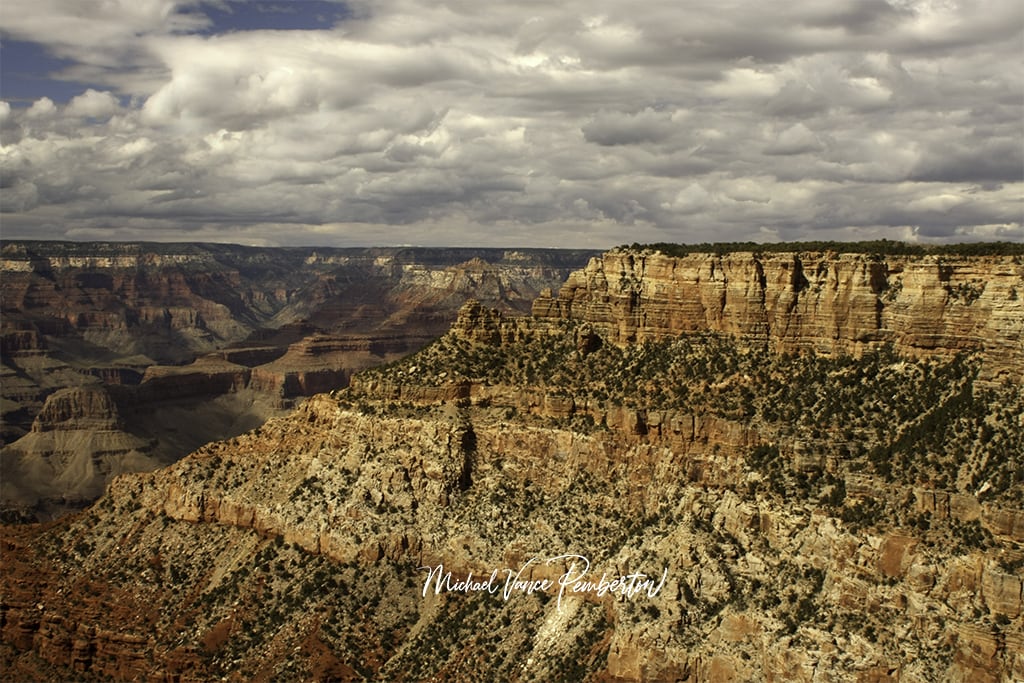
4. Capturing the Canyon’s Scale:
The Scale of Grandeur: Adding Perspective to Grand Canyon Photography:
In the heart of the Grand Canyon, the sheer scale of nature’s masterpiece unfolds in breathtaking dimensions. The magnitude of this geological wonder is not just a number on a map; it’s a visceral experience that demands to be captured through your camera’s lens. Conveying this grandeur, this vastness, in a two-dimensional photograph is an artistic challenge that can be met with ingenuity and relatable elements.
The Grand Canyon’s expansiveness can sometimes defy the scope of human perception. Standing at its rim, you might find comprehending the canyon’s true dimensions difficult. Yet, this challenge presents a unique opportunity for photographers to infuse their images with awe-inspiring scale.
Imagine capturing an image of the Grand Canyon, its towering cliffs and plunging depths spread before you. Now, introduce a human figure to the scene. Suddenly, the proportions snap into focus. The juxtaposition of a solitary individual against the vast backdrop instantly communicates the enormity of the canyon. The figure becomes a storyteller, a point of reference with which the viewer can emotionally connect.
Beyond human figures, elements of nature, such as trees and vegetation, serve a similar purpose. A lone tree clinging to the edge of a cliff or a grove of trees dwarfed by the surrounding canyon walls provides a relatable scale that enhances the impact of the landscape. These natural reference points ground the viewer’s imagination, enabling them to grasp the immensity of the geological formations that define the Grand Canyon.
The impact of these reference points is profound. They invite viewers to immerse themselves in the scene, to imagine the sensation of standing amidst such monumental surroundings. The sense of wonder and insignificance that washes over the viewer parallels the emotions experienced while standing before the actual canyon. These emotions make a photograph of the Grand Canyon not just a visual representation but a conduit for the viewer’s journey of discovery.
In the grand tapestry of nature, including these human and natural elements is akin to signing your photograph with a touch of relatability and emotion. It’s a testament to your ability as a photographer to encapsulate the immeasurable in a single frame. The juxtaposition of the minuscule against the monumental encapsulates the essence of the Grand Canyon, revealing its timeless message: that in the face of nature’s grandeur, we are both humble observers and integral participants.
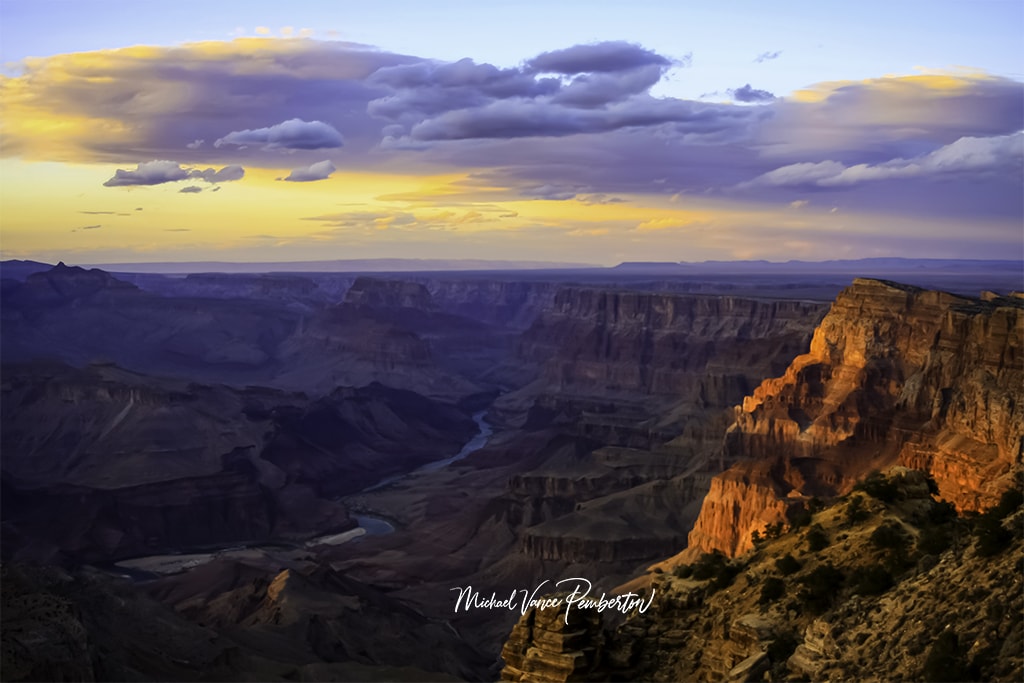
5. Play with Perspectives:
Unveiling the Unseen: Discovering the Grand Canyon’s Microcosms Through Photography.
The Grand Canyon’s reputation as a land of sweeping vistas and breathtaking panoramas is undeniable. Yet, in the grandeur of its vast landscapes, a world of intricate details and hidden stories quietly unfolds. As a photographer, your lens can unlock the secrets of this microcosmic realm, revealing a side of the Grand Canyon that often escapes the casual observer’s notice.
While it’s easy to be captivated by the canyon’s vastness, its true allure lies in the details that add depth and character to its rugged terrain. Eroded rocks bear the marks of millions of years of history, etched by the hands of time and the elements. These intricate patterns, formed by wind and water, are a testament to the ever-changing nature of the Earth’s surface. By zooming in and focusing on these minute details, you can capture the geological story of the Grand Canyon in each intricate line and curve.
The delicate desert flora, often overshadowed by the towering cliffs, paints a vivid tapestry of life’s resilience in the harshest environments. How a cactus’s needles catch the sunlight or a flower clings to a crack in the rock speaks to the remarkable adaptability of life. By zeroing in on these small yet significant elements, you create portraits celebrating the spirit of survival and beauty in adversity.
Water, the sculptor of the canyon’s majesty, weaves its narrative in hidden corners. Tranquil pools mirror the surrounding landscape, offering a portal into a serene world of reflections. These glassy surfaces capture the canyon’s colors, the movement of clouds, and the dance of light, transforming the ordinary into the extraordinary. Through macro and close-up shots, you can immortalize these ephemeral moments of reflection and create a bridge between the tangible and the ethereal.
Macro photography, in particular, opens a portal to the unseen world within the canyon’s embrace. In the intricate network of veins on a leaf or the delicate textures of a rock’s surface, you find a universe of shapes, colors, and patterns that often go unnoticed. These images become a treasure trove of surprises, inviting viewers to explore the canyon from a new perspective.
As you embark on your photographic journey within the Grand Canyon, remember that the beauty lies in the grand landscapes and the hidden details that compose its essence. By focusing your lens on the intimate, the delicate, and the often overlooked, you weave a tale of complexity, resilience, and wonder. Your photographs become more than snapshots; they become a portal through which viewers can journey into the heart of the Grand Canyon’s secrets, discovering a world that remains concealed to the casual observer.
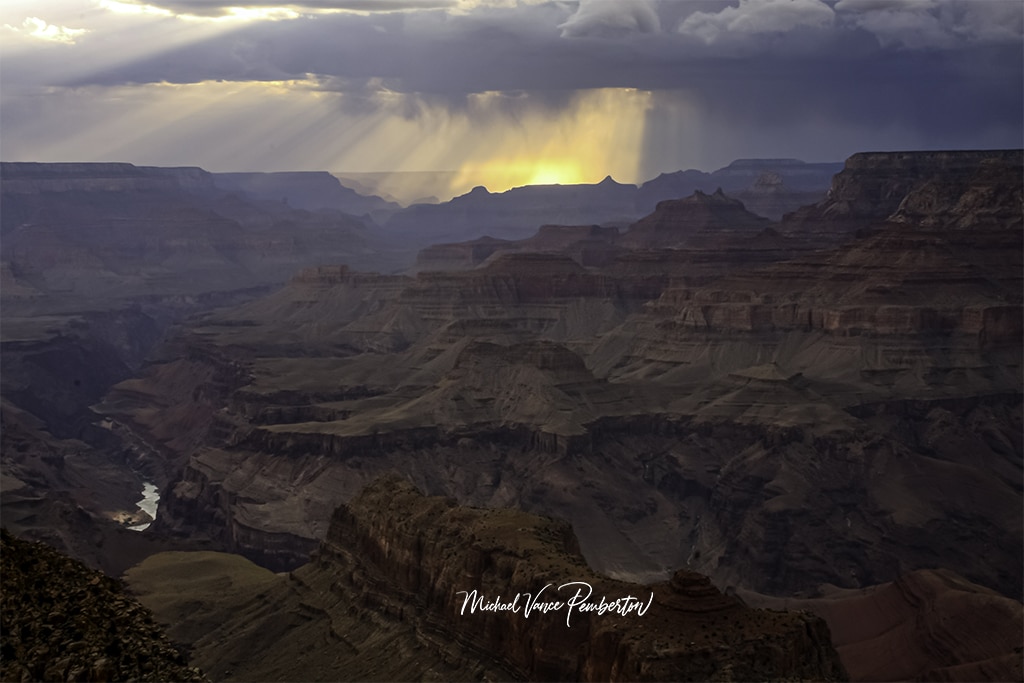
6. Weather and Atmosphere:
Chasing the Skies: Harnessing Weather’s Dynamic Dance for Grand Canyon Photography.
In landscape photography, weather is more than a mere backdrop; it’s an essential partner in the artistic dance that unfolds between you and your subject. Nowhere is this partnership more evident than in the Grand Canyon, where the ever-changing skies and atmospheric conditions play a starring role in the visual narrative. Embracing the capricious nature of weather can elevate your photographs, infusing them with drama, depth, and a touch of the unexpected.
Clouds, those transient painters of the sky, have the power to transform the canyon’s mood in an instant. Their play with sunlight creates a dynamic interplay of shadows and highlights, casting the landscape in perpetual change. These moving textures lend your photographs a sense of life and movement, capturing the canyon as it breathes with the passing of the clouds. The juxtaposition of light and shadow, softened by the diffused glow of cloud cover, can add a layer of depth and emotion that enhances the visual impact of your images.
Mist, too, is a master of transformation. It gracefully rises from the canyon floor or drifts along the river, adding an ethereal quality to your compositions. Mist shrouds the landscape in mystery, inviting viewers to engage in its visual puzzle. The veil of mist can transform familiar scenes into enchanting landscapes, evoking a sense of otherworldly beauty that speaks to the ephemeral nature of the canyon’s moods.
Rain showers, though occasionally challenging, can gift photographers with breathtaking opportunities. Post-storm lighting is a phenomenon that can turn a drab, waterlogged scene into a canvas of vibrant colors and extraordinary contrast. The moisture on the canyon’s surfaces creates a magical interplay with sunlight, resulting in a palette of colors that appear to dance on the rocks. This unique lighting brings out the canyon’s hues in vivid detail and, when captured skillfully, can lead to photographs that embody the raw, untouched beauty of the moment.
Adapting to the whims of weather is both an art and a skill. Patience becomes your ally as you await the perfect moment to press the shutter while remaining open to the unexpected. The Grand Canyon’s dramatic landscapes are a testament to the ever-changing nature of the world, and your photographs should reflect this dynamic spirit. The most remarkable images often emerge from the most unpredictable conditions – it’s in the fusion of your artistic vision with nature’s whims that photographic magic is born.
In Grand Canyon photography, the weather is not an obstacle; it’s a collaborator, an essential element that can make or break an image. By embracing its variability, you invite a sense of adventure and spontaneity into your creative process. Weather’s gift is its ability to infuse your photographs with emotion and atmosphere, to make them resonate with the ever-shifting soul of the canyon. You craft a visual story that captures the canyon’s physical form, essence, spirit, and ever-changing heart through rain and mist, clouds, and sunbeams.
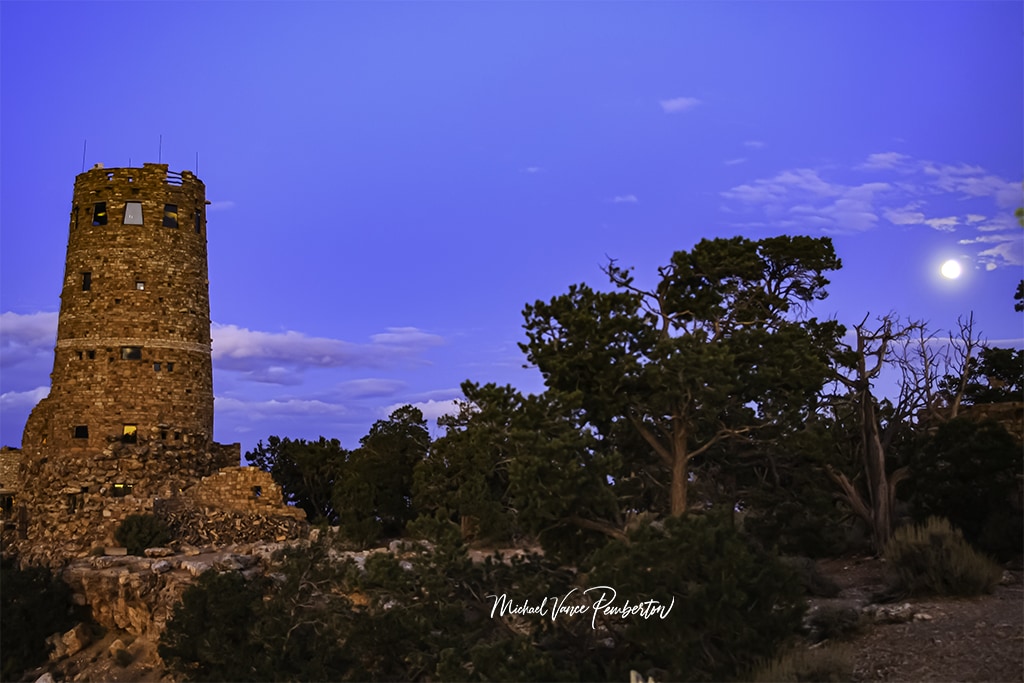
7. Post-Processing with Care:
Crafting the Final Vision: Post-Processing and the Art of Authenticity.
In modern photography, post-processing stands as the digital darkroom, offering photographers the tools to refine and perfect their captured moments. While it presents many possibilities, its judicious use is critical to maintaining the authenticity and inherent beauty of the Grand Canyon in your images. The goal is not to create a new landscape but to accentuate the canyon’s magnificence and evoke the emotions it inspires.
Enhancing colors and adjusting contrast can breathe new life into your photographs, allowing the vibrant hues of the canyon to leap off the screen or print. However, it’s essential to tread lightly and exercise restraint. Over-processing, while tempting in its potential for creating striking visuals, can lead to results that veer into the realm of the unnatural. The Grand Canyon’s allure lies in its natural splendor, untamed forms, and raw beauty. Overzealous post-processing risks distorting this authenticity, diluting the genuine connection that viewers can forge with the landscape.
The guiding principle of post-processing should be to reveal, not to transform. Your role is akin to a curator, delicately coaxing out the hidden intricacies that may not have been fully captured in the initial exposure. Adjustments should respect the original spirit of the scene, preserving the interplay of light and shadow, the grandeur of the vistas, and the textures etched by time. The goal is not to mold the canyon to your vision but to enhance the elements that already exist in harmony.
Photographing the Grand Canyon is a blend of privilege and challenge – a remarkable opportunity to translate the wonders of nature into a tangible visual form. Each photograph becomes a window into your unique perspective, a testament to your creativity, and a bridge for others to traverse into the realm of awe and admiration that the canyon evokes.
As you embark on this photographic journey, remember that the Grand Canyon is a living canvas that changes with the seasons, the light, and the weather. Each visit presents an opportunity for new discoveries, fresh images, and the chance to reinterpret its beauty from a different angle. By mastering the technical aspects of photography – from light manipulation to composition – you become a storyteller, encapsulating the timeless spirit of this geological wonder.
Pack your camera gear with a sense of excitement and adventure. Allow the canyon’s grandeur to be the backdrop against which your creative vision unfolds. Approach your craft with respect for the landscape and a commitment to authenticity. Ultimately, your photographs will serve as a testament to your skill and the enduring splendor of the Grand Canyon – a treasure trove of memories and emotions frozen in time.
In conclusion, photographing the Grand Canyon is both a privilege and a challenge. It’s an opportunity to capture nature’s masterpiece through your unique perspective. Remember that each visit to the canyon offers a chance for new discoveries and fresh images. By mastering the interplay of light, composition, and subject matter, you can immortalize the awe-inspiring beauty of the Grand Canyon in your photographs. So pack your camera gear, embrace the adventure, and let your creative vision unfold against the backdrop of this geological wonder.


Recent Posts
In shadows cast by love's deceitful guise,He wandered blind, his heart the captive prize.Through realms unknown, where truth remained concealed,He followed trails of falsehood, unrevealed. Blinded...
Prepare to be amazed as the MCAS Cherry Point Air Show returns on May 11-12. This annual event, hosted by the Marine Corps Air Station (MCAS) Cherry Point in North Carolina, promises a weekend of...